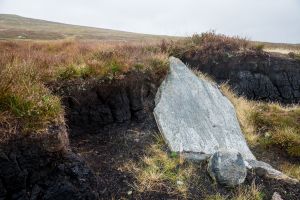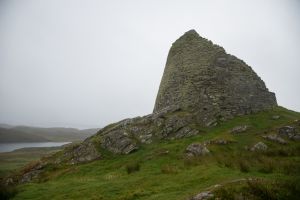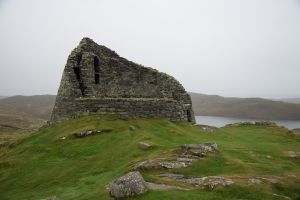Can you say “Scottish Stone Circles” three times, fast? I can’t.
I included the picture with the dog in it mostly to give some perspective on the size of the big rocks that make up the Callanish (or Calanais) Stone Circles. The biggest ones are probably ten feet tall. The main circle sits on a hilltop on the west side of the island called Lewis & Harris in far west Scotland. There’s actually a person in one of the other pictures — can you spot her? There are lots of those stone circles all around Scotland — in fact there were two other (smaller ones) within sight of the big one at Callanish (the last three photos in the grid below).
I just missed the better image of the dog that had happened a few seconds prior — of course he had hiked his leg on those 5,000-year-old Stone Age relics. I know they’re just giant rocks, but there’s something odd about the fact that these stone circles sit unguarded and unprotected on a barren hillsides, where a regular stream of visitors shows up to touch them, climb on them, and let their dogs pee on them. Sheep graze among them. One family was playing hide-and-seek behind them. The neolithic megaliths are unphased.
Nobody knows for sure, but it’s generally assumed they might have something to do with a ceremony or ritual of some sort. Recent archaeology digs have revealed structures near some of the circles that are surprisingly sophisticated. The late Stone Age builders of these circles weren’t the cave men you may imagine (Neanderthals lived at least 30,000 years ago; these ruins are “only” 5,000 years old). Very recent work at a similar, nearby site in far north Scotland shows that the neolithic farmers who built these circles had art, masonry homes, and extensive agriculture. (Like Fred Flintstone without the dinosaurs?) At 5,000 years old, the Scottish stone circles are from about the same era (or maybe a little older) as Stonehenge, which is a few hundred miles to the south, in England. These folks would have looked pretty much like modern Europeans do. In fact, based on a scientific reconstruction, I may look more ‘neanderthal’ than they did — at least when I haven’t shaved.
(Photographers: I had no tripod, no assistant, no lightstands and just one small flash unit, so I didn’t get very creative with the stone circle pictures, and I didn’t bother staying past dark. Some of these shots do have that single flash unit (triggered remotely) propped up on a rock or camera bag and pointed toward some of the stones. I just exposed for the ambient light (minus a stop or two), then experimented with the flash on manual settings.)
==================
CARLOWAY: Not far from the Callanish stones is another stone relic, but one from a much more recent era — “only” 2,000 years ago. It’s the Carloway Broch. A brooch is a round double-walled building made of stacked (no grout or cement) stones. It’s unclear if it was a fort, a castle-like home, or perhaps a factory, of sorts, for pottery. Like the Callanish Stones nearby, you’re likely to have the place to yourself if you visit — except for the sheep.


















